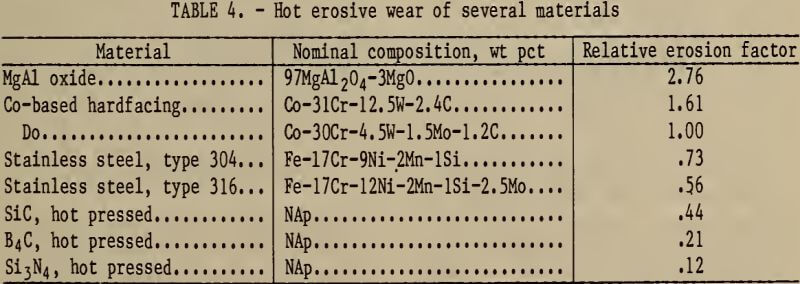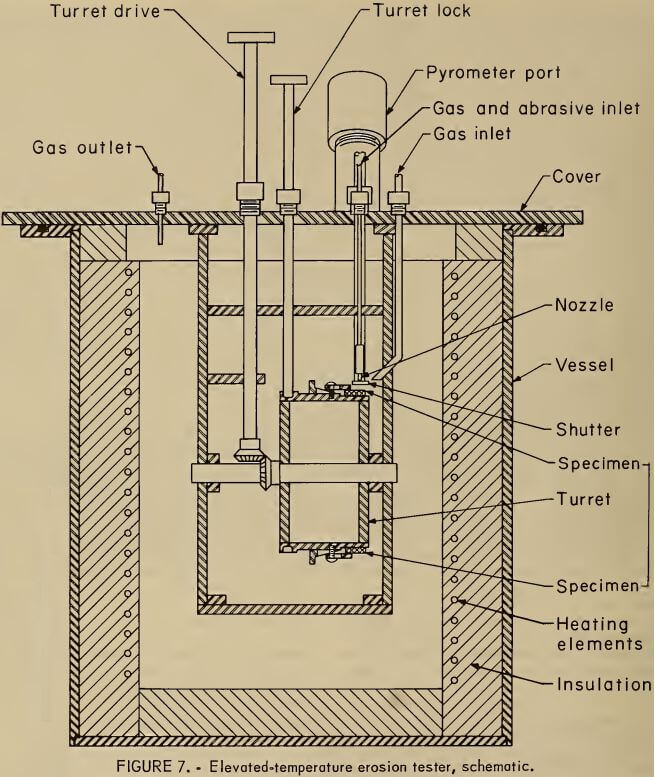Table of Contents
Many industrial materials are subject to high-velocity abrasive particles at elevated temperature. Wear of this type is found, for example, in hot dust collection equipment. In order to select and develop materials for high-temperature use and to study the basic mechanisms of hot erosion, a laboratory test is necessary. Much has been learned about erosion at ambient temperature, but elevated-temperature work has been very limited. An apparatus suitable for studying hot erosion was designed and constructed by the Bureau. The test conditions are similar to those of the dry-particle erosive wear test, just discussed, except that the temperature can be elevated and the atmosphere can be controlled.
Three elevated-temperature erosion test devices have been reported. Doyle and Levy described a device capable of testing specimens from room temperature to 1,000° C with particle velocities ranging from 30 to 180 m/s. The angle of impingement could be varied. The specimen was heated in a small furnace, and the gas particle mixture was preheated. Young and Ruff described a similar device, except the specimen was heated by passing an electrical current through it. Hansen described the Bureau’s apparatus in greater detail.
Elevated-Temperature Erosive Equipment and Specimens
The elevated-temperature erosion tester devised by the Bureau is shown schematically in figure 7. The apparatus consists of a vessel that contains a multiple-specimen holder on a turret, an electrical resistance heating element, a particle delivery nozzle, a shutter to control the abrasive blast duration, thermocouples, and an infrared pyrometer to monitor the temperature of the specimen surface within 10° C. The abrasive particles, typically 27-µm Al2O3, are delivered by an Airbrasive unit, as described in the preceding section. The particle delivery nozzle consists of a molybdenum shank about 4 cm long and a 1.3-cm sapphire tip, 0.058 cm in ID. The multiple specimen holder accommodates 12 specimens, any one of which can be positioned beneath the nozzle during a run. The angle of incidence of the particles striking the specimen can be set by placing a wedge under the specimen. A vent in the vessel allows the driving gas to escape.
Test specimens are approximately 1.5 by 1.5 by 0.2 cm. The test surface is ground through 400-grit abrasive.
Elevated-Temperature Erosive Procedure
Specimens are cleaned, dried, and weighed before testing. After 12 specimens are placed on the turret, the test chamber is sealed, heated in a partial vacuum, and filled with the desired gas, typically nitrogen. About 30 min is required to attain a temperature of 700° C. With the shutter closed between the nozzle and the specimen, the particle blast is started. After steady-state conditions are reached, the shutter is opened and the first sample is eroded for the desired time, typically 3 min. The remaining 11 specimens are eroded in the same manner. The furnace is then cooled by a stream of nitrogen gas and the specimens are removed, cleaned, and reweighed.
Three standard specimens made of Haynes Stellite wrought alloy 6B are run with the nine test specimens in each test. The volume loss of each specimen is calculated from its weight loss and density. The data are reported as the ratio of volume loss to the average volume loss for the three Stellite standard specimens. This ratio is referred to as the relative erosion factor (REF).
Elevated-Temperature Erosive Results
Table 4 contains erosion data for several materials tested at 700° C using

Note.—700° C, 90° impingement, 27-µm Al2O3 particles, 5-g/min particle flow, 170- m/s particle velocity, 3-min test duration, N2 atmosphere.

nitrogen gas and 27-µm Al2O3 particles at 90° impingement. The data reflect the average values for a set of five tests. One standard deviation of a set of tests was typically within 10 pct of the mean. The data reported include a wide range of REF values.
